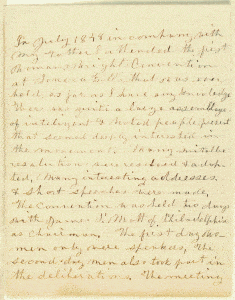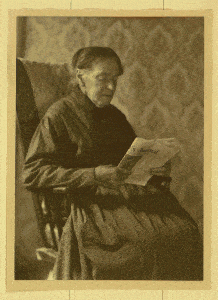Rhoda Palmer
2023 marks the 175th anniversary of the 1848 Women’s Rights Convention. Through Rhoda Palmer (1816-1919) there is a Geneva connection to the convention.

Except of Rhoda Palmer’s account of the 1848 Women’s Rights Convention. Courtesy of the Library of Congress
Though she never officially joined the Quakers Palmer regularly attended the Junius Monthly Meeting. It’s through her Quaker ties that she learned about the women’s rights convention in Seneca Falls being held in July 1848. The convention was the first political gathering called specifically to address the rights of women. Palmer and her father were among the over 300 people who attended the convention and Palmer was one of the signers of the Declaration of Sentiments. In 1908 Palmer wrote one of the few eyewitness accounts of the convention:
There was quite a large assemblage of intelligent and noted people present that seemed deeply interested in the movement. Many suitable resolutions were resolved and voted. Many interesting addresses and short speeches were made…Good results have followed that first equal suffragist gathering. The seed fell on good ground. But the end is not yet. Nor will it be until women can claim what rightfully belongs to them and the time is not far distant when this will be accomplished. The world progresses not backwards but forwards encouraging thought.
Below is a biography of Palmer from the Historical Society’s June 1998 newsletter.
For information about Convention Days in Seneca Falls, click here.
Of all the signers of the 1848 Declaration of Sentiments, only Rhoda Palmer lived to vote, not in 1920 as result of the 19th Amendment, but in 1918, when New York State passed its own women suffrage law. Palmer’s vote was the culmination of a long-time dream—the fulfillment of ideals of equality that she had developed from her earliest years as a Quaker, an abolitionist, and a woman’s right activist.
Rhoda Palmer was born on June 25, 1816, the seventh of nine children, born to Asa Palmer and Abigail Wooden Palmer in a house in a house built by her father on Lyons Road, two miles north of Geneva. Her father was a farmer, born in Rhode Island. Her mother came from Orange County, New York. By 1850, neither rich nor poor, they had acquired land, livestock, tools, and buildings worth about $3500.
As a teenager, Rhoda Palmer saw her world expand. She attended the young ladies’ seminary in Geneva. She saw the launching of the first steamboat, the Seneca Chief, on Seneca Lake. The Erie Canal had been finished in 1825. In the summer of 1836, when she was twenty-one years old she traveled to Chicago, then a small town of only 6,000 people. She took the Erie Canal to Buffalo and rode steamboats on the Great Lakes. She saw Niagara Falls for the first time in 1840, and she traveled widely to Philadelphia, New York, New England, and the Upper Midwest.
All her life, Rhoda Palmer was influenced by the ideals of equality rooted in the religious tradition of the Society of Friends. Although she was not a birthright Friend (her parents had joined Junius Monthly Meeting in 1818, after Rhoda’s birth), and she never officially joined a Quaker meeting, she always considered herself a Quaker, and she regularly attended Junius Monthly Meeting. Her equalitarian religious beliefs remained important to her to the end of her life. Even as an old lady, she was proud to claim descent from Roger Williams founder of Rhode Island, where Quakers, Jews, Baptists, and other unwelcome in Massachusetts Bay could take refuge.
As a Quaker at Junius Monthly Meeting, she met the M’Clintocks, the Priors, the Bonnels, and other strong advocates for abolitionism and women’s rights. She and her family promoted these values in their own lives. Her father, she remembered, “was a great anti-slavery man,” and they hosted self-emancipated slaves who came through their home on their way to Lake Ontario and Canada. She also heard Sojourner Truth and other abolitionists lecturers. In 1848, she attended the Geneva Medical College’s commencement ceremony, and there she saw the first woman (Elizabeth Blackwell) as well as the first Native American (Peter Wilson, a Seneca) graduate from medical school.
Through this Quaker-abolitionist network, she learned about the proposed convention to discuss the “social, civil, and religious condition and rights of women” at Seneca Falls. Many years later in 1915, when she was 99 years old, Rhoda Palmer wrote one of the few eyewitness accounts of that meeting. “It was largely attended,” she remembered. “There was a variety of Quakers (or friends as they called themselves) living in the town of Waterloo nearby. I think without exception every member was present… The session lasted two days. My self and father, Asa Palmer, attended it. Had an enjoyable time, excepting one little incident. Our carriage broke down on our way home and we were obliged to stay over night on the road.”
Rhoda Palmer never wavered in her commitment to women’s rights. Through her travels, she connected local efforts to national reform. In 1853 she attended a convention in New York City, where abolitionists, women’s rights advocates and temperance reformers all gathered. There she listened to such famous abolitionists as William Lloyd Garrison and Wendell Phillips. She remembered Ernestine Rose, born a Polish Jew, whose broken English made her the target of ridicule from young men in the audience. Palmer was especially impressed by Lucretia Mott. When Mott faced a long harangue from a man who believed, with St. Paul, that women should learn from their husbands at home, she simply waited quietly until he was finished, noted that “I don’t agree,” and quietly continued her own talk. Palmer, who always had a good sense of humor, also told a story a story about Horace Greeley, editor of the New York Tribune, perhaps the most influential paper in the county. To help the cause, Greeley organized a huge vegetarian banquet. He was worried, however, remembered Palmer, because there was no tomato soup.
In her later years, Rhoda Palmer became an accomplished painter. She lived in the house she had been born in until she was 94 years old, when an injury forced her to move two doors away to live with her nephew. There she entertained friends, read, and maintained her strong commitment to women’s rights.
When local suffragists renewed their efforts to win the vote in the early twentieth century, they made an annual pilgrimage to visit Rhoda Palmer on her birthday. On the first Tuesday in November 1918, when Rhoda Palmer was 102 years old, she was driven to the polls to cast her first ballot. “Her one wish that she would live to vote,” noted the local newspaper, “was realized.
She died on August 9, 1919, aged 103 years old. She was buried with her parents and two of her brothers in the Quaker cemetery on Nine-Foot Road in Waterloo, New York.


Readers may like to see this photo of Rhoda Palmer taken Nov. 6, 1918 in Agnes Slosson Lewis’ limo, as she was driven to the polls to vote. On the seat with her is Elizabeth Slosson Lewis Brew, the Lewis daughter born on May 23, 1917. 101 years difference in their ages.
https://photos.app.goo.gl/67YWchAWxMDoMEsE6
Thanks very much for posting the article and Mr. Weinstock’s info and the photo. She is a fascinating study. She voted 4 months after my mother, who was raised in Geneva and lived to be 101, was born. Not so long ago for those who appreciate history.
I visited Ms. Palmer’s grave two years ago. Cemetery is easy to miss as it sits back on thedeast side of the road. Not far off Rt. 96. For anyone visiting there, the grave is located in the front on the far right. Grave stone was legible when I was there.
Very interesting. Thank you.
What a life for a woman of her time.
She was a great women’s right fighter.
I have visited the cemetery but didn’t know she was buried there.
I will visit again.
Thanks Danny for the photo of Rhoda Palmer voting.
Thank you for an uplifting article.